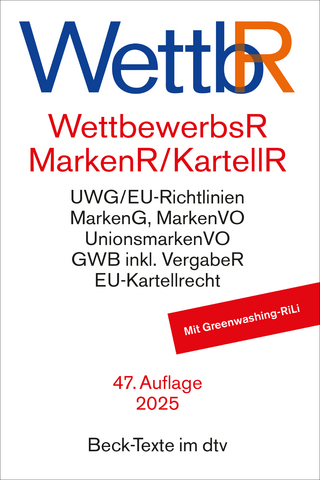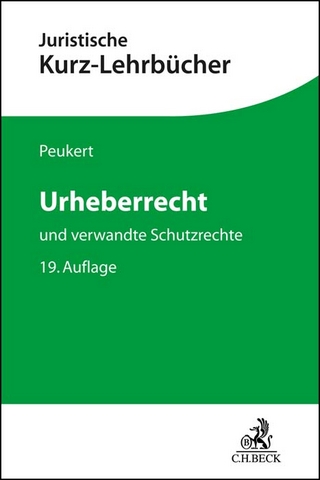
The Economics of Intellectual Property
Edward Elgar Publishing Ltd (Verlag)
978-1-84064-351-0 (ISBN)
This authoritative four-volume collection presents the most important published articles and papers on the economics of intellectual property - a subject that is of increasing interest to both economists and lawyers. Publication is timely in view of the growing interest in the relationship of innovation and knowledge to economic growth as well as the challenges to copyright being posed by the new electronic media. International in scope, this four-volume set will be an essential source of reference to both economists and lawyers concerned with the rapidly developing field of intellectual property.
Edited by Ruth Towse, Professor of Economics of Creative Industries, CIPPM, Bournemouth University and CREATe Fellow in Cultural Economics, University of Glasgow, UK and Rudi Holzhauer, Senior Lecturer in Law, Erasmus University Rotterdam, the Netherlands
Contents:
Volume I: Introduction and Copyright
Acknowledgements
Introduction Ruth Towse and Rudi Holzhauer
PART IINTRODUCTION TO THE ECONOMICS OF INTELLECTUAL PROPERTY
1. Stanley M. Besen (1998), ‘Intellectual Property’
2. Ejan Mackaay (1990), ‘Economic Incentives in Markets for Information and Innovation’
3. Tom G. Palmer (1989), ‘Intellectual Property: A Non-Posnerian Law and Economics Approach’
4. Robert P. Merges (1994), ‘Of Property Rules, Coase, and Intellectual Property’
5. Lisa N. Takeyama (1994), ‘The Welfare Implications of Unauthorized Reproduction of Intellectual Property in the Presence of Demand Network Externalities’
PART IICOPYRIGHT
6. Gillian K. Hadfield (1992), ‘The Economics of Copyright: An Historical Perspective’
7. Leo J. Raskind (1998), ‘Copyright’
8. Wendy J. Gordon and Robert G. Bone (2000), ‘Copyright’
9. Arnold Plant (1934), ‘The Economic Aspects of Copyright in Books’
10. Ian E. Novos and Michael Waldman (1984), ‘The Effects of Increased Copyright Protection: An Analytic Approach’
11. William R. Johnson (1985), ‘The Economics of Copying’
12. William M. Landes and Richard A. Posner (1989), ‘An Economic Analysis of Copyright Law’
13. Stephen Breyer (1970), ‘The Uneasy Case for Copyright: A Study of Copyright in Books, Photocopies, and Computer Programs’
PART IIIAPPLICATIONS TO SPECIFIC AREAS OF COPYRIGHT
14. Wendy J. Gordon (1982), ‘Fair Use as Market Failure: A Structural and Economic Analysis of the Betamax Case and its Predecessors’
15. I.T. Hardy (1988), ‘An Economic Understanding of Copyright Law’s Work-Made-for-Hire Doctrine’
16. S.J. Liebowitz (1985), ‘Copying and Indirect Appropriability: Photocopying of Journals’
17. Stanley M. Besen, Willard G. Manning, Jr. and Bridger M. Mitchell (1978), ‘Copyright Liability for Cable Television: Compulsory Licensing and the Coase Theorem’
PART IVADMINISTRATION OF COPYRIGHT
18. Hector L. MacQueen and Alan Peacock (1995), ‘Implementing Performing Rights’
19. Ruth Towse (1999), ‘Copyright and Economic Incentives: An Application to Performers’ Rights in the Music Industry’
PART VDROIT DE SUITE
20. Jeffrey M. Perloff (1998), ‘Droit de Suite’
21. John L. Solow (1998), ‘An Economic Analysis of the Droit de Suite’
22.Henry Hansmann and Marina Santilli (1997), ‘Authors’ and Artists’ Moral Rights: A Comparative Legal and Economic Analysis’
Name Index
Volume II: Patents
Acknowledgements
An Introduction by the editors to all four volumes appears in Volume I
PART ITHE NATURE OF PATENTS AND THE PATENT SYSTEM
1. Edmund W. Kitch (1998), ‘Patents’
2. Fritz Machlup and Edith Penrose (1950), ‘The Patent Controversy in the Nineteenth Century’
3. Arnold Plant (1934), ‘The Economic Theory Concerning Patents for Inventions’
4. Edmund W. Kitch (1977), ‘The Nature and Function of the Patent System’
5. Edmund W. Kitch (1986), ‘Patents: Monopolies or Property Rights?’
6. Kenneth W. Dam (1994), ‘The Economic Underpinnings of Patent Law’
7. Fritz Machlup (1958), An Economic Review of the Patent System: Study of the Subcommittee on Patents, Trademarks, and Copyrights of the Committee on the Judiciary
8. Erich Kaufer (1986), ‘The Incentives to Innovate under Alternative Property Rights Assignments with Special Reference to the Patent System’
9. Suzanne Scotchmer (1996), ‘Patents as an Incentive System’
10. Yoram Barzel (1968), ‘Optimal Timing of Innovations’
11. Jennifer F. Reinganum (1989), ‘The Timing of Innovation: Research, Development, and Diffusion’
12. F.M. Scherer (1977), The Economic Effects of Compulsory Patent Licensing
13. Pankaj Tandon (1982), ‘Optimal Patents with Compulsory Licensing’
14. Jean O. Lanjouw, Ariel Pakes and Jonathan Putnam (1998), ‘How to Count Patents and Value Intellectual Property: The Uses of Patent Renewal and Application Data’
PART IIPATENT SCOPE AND DURATION
15. D.G. McFetridge and M. Rafiquzzaman (1986), ‘The Scope and Duration of the Patent Right and the Nature of Research Rivalry’
16. Roger L. Beck (1986), ‘Comment: Does Competitive Dissipation Require a Short Patent Life?’
17. M. Rafiquzzaman (1987), ‘The Optimal Patent Term Under Uncertainty’
18. Richard Gilbert and Carl Shapiro (1990), ‘Optimal Patent Length and Breadth’
19. Robert P. Merges and Richard R. Nelson (1990), ‘On the Complex Economics of Patent Scope’
20. Paul Klemperer (1990), ‘How Broad Should the Scope of Patent Protection Be?’
21. Joshua Lerner (1994), ‘The Importance of Patent Scope: An Empirical Analysis’
22. Paul A. David and Trond E. Olsen (1992), ‘Technology Adoption, Learning Spillovers, and the Optimal Duration of Patent-based Monopolies’
Name Index
Volume III: Empirical Evidence, Trade Secrets and Trademarks
Acknowledgements
An Introduction by the editors to all four volumes appears in Volume I
PART IEMPIRICAL EVIDENCE ON PATENTS
1. Edwin Mansfield, Mark Schwartz and Samuel Wagner (1981), ‘Imitation Costs and Patents: An Empirical Study’
2. Edwin Mansfield (1984), ‘R & D and Innovation: Some Empirical Findings’ and ‘Reply’
3. Edwin Mansfield (1986), ‘Patents and Innovation: An Empirical Study’
4. Richard C. Levin (1986), ‘A New Look at the Patent System’
5. K.H. Oppenländer (1986), ‘The Influence of the Patent System on the Readiness of Industry to Invest - An Empirical Analysis’
6. Adam B. Jaffe (1986), ‘Technological Opportunity and Spillovers of R & D: Evidence from Firms’ Patents, Profits and Market Value’
7. Mark A. Lemley (1994), ‘An Empirical Study of the Twenty-year Patent Term’
8. Mariko Sakakibara and Lee Branstetter (2001), ‘Do Stronger Patents Induce More Innovation? Evidence from the 1988 Japanese Patent Law Reforms’
PART IITRADE SECRETS
9. David D. Friedman (1998), ‘Trade Secret’
10. Edmund W. Kitch (1980), ‘The Law and Economics of Rights in Valuable Information’
11. Steven N.S. Cheung (1982), ‘Property Rights in Trade Secrets’
12. David D. Friedman, William M. Landes and Richard A. Posner (1991), ‘Some Economics of Trade Secret Law’
13. Paul A. David (1993), ‘Intellectual Property Institutions and the Panda’s Thumb: Patents, Copyrights, and Trade Secrets in Economic Theory and History’
PART IIITRADEMARKS
14. Nicholas Economides (1998), ‘Trademarks’
15. A.G. Papandreou (1956), ‘The Economic Effect of Trademarks’
16. Nicholas S. Economides (1988), ‘The Economics of Trademarks’
17. William M. Landes and Richard A. Posner (1988), ‘The Economics of Trademark Law’
18. I.P.L. Png and David Reitman (1995), ‘Why Are Some Products Branded and Others Not?’
19. Stephen L. Carter (1989), ‘The Trouble with Trademark’
20. Rudi W. Holzhauer (1998), ‘Jenever and Jumping Wild Cats: The Scope of Trade Mark Protection in Economics and in Law’
21. Robert Feinberg (1986), ‘Trademarks, Market Power, and Information’
22. Mark A. Hurwitz and Richard E. Caves (1988), ‘Persuasion or Information? Promotion and the Shares of Brand Name and Generic Pharmaceuticals’
23. Jochen Pagenberg (1988), ‘Trademark Rights at a Discount – Is Trademark Law Still Effective?’
Name Index
Volume IV: Competition and International Trade
Acknowledgements
An Introduction by the editors to all four volumes appears in Volume I
PART ICOMPETITION ISSUES – GENERAL
1. Richard A. Posner (1975), ‘The Social Costs of Monopoly and Regulation’
2. Nancy T. Gallini and Michael J. Trebilcock (1998), ‘Intellectual Property Rights and Competition Policy: A Framework for the Analysis of Economic and Legal Issues’
3. Richard A. Epstein (1982), ‘Private Property and the Public Domain: The Case of Antitrust’
4. Valentine Korah (1986), ‘EEC Competition Policy – Legal Form or Economic Efficiency?’
5. Alexis Jacquemin (1988), ‘Cooperative Agreements in R&D and European Antitrust Policy’
6. Alan Gutterman (1997), ‘Inter-Firm Co-operation, Competition Law, and Patent Licensing: A US-EC Comparison’
7. William F. Baxter and Daniel P. Kessler (1998), ‘The Law and Economics of Tying Arrangements: Lessons for the Competition Policy Treatment of Intellectual Property’
8. Thomas F. Cotter (1999), ‘Intellectual Property and the Essential Facilities Doctrine’
PART IIPARALLEL IMPORTS
9. J.S. Chard and C.J. Mellor (1989), ‘Intellectual Property Rights and Parallel Imports’
10. Lars H. Liebeler (1986), ‘Trademark Law, Economics and Grey-market Policy’
11. John A. Young, Jr. (1986), ‘The Gray Market Case: Trademark Rights v. Consumer Interests’
12. John C. Hilke (1988), ‘Free Trading or Free-riding: An Examination of the Theories and Available Empirical Evidence on Gray Market Imports’
13. Frederick M. Abbott (1998), ‘First Report (Final) to the Committee on International Trade Law of the International Law Association on the Subject of Parallel Importation’
14. John Rhys, Theon van Dijk, Peter Goate, David Lewis, Franz Gerner, Simon Holmes, David Rose, Tom Usher and David Spilsbury (1999), ‘Executive Summary’
15. Patricia M. Danzon (1998), ‘The Economics of Parallel Trade’
16. Harvey E. Bale, Jr. (1998), ‘The Conflicts Between Parallel Trade and Product Access and Innovation: The Case of Pharmaceuticals’
PART IIIWTO/TRIPS
17. Michael McKee (1986), ‘You Can’t Always Get What You Want: Lessons from the Paris Convention Revision Exercise’
18. Carlos Alberto Primo Braga (1989), ‘The Economics of Intellectual Property Rights and the GATT: A View From the South’
19. Robert D. Anderson (1998), ‘The Interface Between Competition Policy and Intellectual Property in the Context of the International Trading System’
20. J.H. Reichman (1997), ‘From Free Riders to Fair Followers: Global Competition Under the TRIPS Agreement’
PART IVSTANDARDISATION ISSUES
21. Richard C. Levin (1978), ‘Technical Change, Barriers to Entry, and Market Structure’
22. Joseph Farrell (1989), ‘Standardization and Intellectual Property’
Name Index
| Erscheint lt. Verlag | 26.4.2002 |
|---|---|
| Reihe/Serie | The International Library of Critical Writings in Economics series |
| Verlagsort | Cheltenham |
| Sprache | englisch |
| Maße | 169 x 244 mm |
| Themenwelt | Recht / Steuern ► EU / Internationales Recht |
| Recht / Steuern ► Wirtschaftsrecht ► Urheberrecht | |
| Wirtschaft ► Volkswirtschaftslehre | |
| ISBN-10 | 1-84064-351-X / 184064351X |
| ISBN-13 | 978-1-84064-351-0 / 9781840643510 |
| Zustand | Neuware |
| Informationen gemäß Produktsicherheitsverordnung (GPSR) | |
| Haben Sie eine Frage zum Produkt? |
aus dem Bereich


